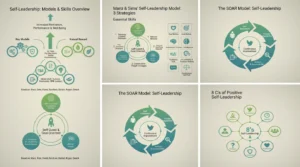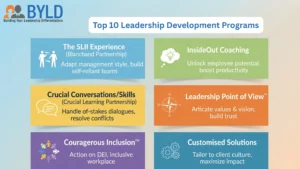
The Role of Business Development Training in Corporate Success
- Our Subject Matter Experts
- April 25, 2025
- 10:23 am
- No Comments

Introduction
In today’s dynamic and highly competitive business landscape, companies are constantly striving to outpace their rivals and adapt to evolving market conditions. While innovative products and services are critical, a company’s ability to succeed often hinges on its human capital. This is where business development training becomes invaluable. Business development training equips employees with the necessary skills and knowledge to identify and seize new opportunities, foster strategic partnerships, and drive sustainable growth.
Effective business development training is crucial for enhancing a company’s competitive edge and achieving corporate success. By investing in this training, businesses can ensure that their team members are well-prepared to handle the complexities of modern markets, manage relationships effectively, and make strategic decisions that align with the company’s goals.
Understanding Business Development Training
Business development training is designed to enhance employees’ skills in generating new business opportunities, managing client relationships, and implementing strategic initiatives. This training typically covers a range of topics that are crucial for business growth and development.
Core Aspects of Business Development Training
1. Sales Techniques and Strategies: Sales techniques form the backbone of business development. Effective business development training provides employees with the tools and strategies necessary for identifying potential clients, engaging with them, and closing deals successfully. This includes training on persuasive communication, negotiation skills, and understanding customer needs. Mastering these techniques helps employees not only to attract new clients but also to retain existing ones, contributing to long-term corporate success.
2. Market Research and Analysis: Understanding market trends and customer behavior is essential for making informed business decisions. Business development training involves teaching employees how to conduct market research, analyze data, and identify emerging opportunities. This aspect of training helps businesses stay ahead of competitors by adapting to changing market conditions and seizing opportunities that others may overlook.
3. Relationship Building: Building and maintaining strong relationships with clients and partners is a crucial element of business development. Training programs emphasize the importance of effective communication, networking, and customer service. Employees learn how to establish trust and rapport with stakeholders, which is vital for securing deals and fostering long-term business relationships. This focus on relationship building contributes significantly to a company’s corporate success.
4. Strategic Planning: Strategic planning involves setting goals, developing strategies, and allocating resources to achieve business objectives. Business development training helps employees understand how to create and execute strategic plans that align with the company’s vision and goals. Effective strategic planning ensures that business development efforts are targeted and aligned with the broader organizational strategy, thereby driving corporate success.
5. Problem-Solving and Innovation: Business development often requires creative problem-solving and innovation. Training programs encourage employees to think critically and develop innovative solutions to challenges. This component of training helps businesses adapt to changes, overcome obstacles, and explore new avenues for growth, thereby enhancing their competitive position and supporting corporate success.
Business development training is not a one-size-fits-all approach; it must be tailored to meet the specific needs and goals of each organization. By customizing the training program, companies can address their unique challenges and leverage their strengths, ultimately contributing to their overall corporate success.
Read More – Top Corporate Training Companies in India and Their Role in Developing Leaders
Importance of Business Development Training
Business development training is essential for several reasons, each contributing to the growth and success of a company. Here’s a detailed look at why this training is so crucial:
1. Driving Revenue Growth: One of the primary objectives of business development training is to drive revenue growth. Training equips employees with the skills needed to identify and capitalize on new business opportunities, which directly impacts sales and profitability. By enhancing employees’ abilities to generate leads, close deals, and expand the customer base, businesses can achieve significant revenue growth and improve their financial performance.
2. Enhancing Competitive Advantage: In a competitive market, having a skilled business development team can provide a substantial advantage. Employees who are well-trained in market analysis, sales strategies, and relationship management can help the company stand out from its competitors. This competitive edge is crucial for attracting new clients, retaining existing ones, and positioning the company as a leader in its industry.
3. Building Strong Client Relationships: Strong client relationships are the foundation of business success. Business development training emphasizes the importance of building and nurturing these relationships. Employees learn how to communicate effectively, understand client needs, and provide exceptional service. By fostering strong relationships, companies can secure repeat business, generate referrals, and enhance their reputation in the market.
4. Improving Strategic Planning: Strategic planning is essential for aligning business development efforts with organizational goals. Business development training helps employees understand how to develop and implement strategic plans that support the company’s objectives. Effective planning ensures that resources are allocated efficiently and that business development initiatives are focused on achieving desired outcomes, leading to overall corporate success.
5. Enhancing Problem-Solving Skills: Business development often involves overcoming challenges and finding innovative solutions. Training programs that focus on problem-solving techniques prepare employees to tackle obstacles effectively. This capability is crucial for maintaining momentum and ensuring that business development efforts are not hindered by unforeseen issues. Enhanced problem-solving skills contribute to the successful execution of business development strategies and support corporate success.
6. Supporting Organizational Growth: As businesses grow, they encounter new challenges and opportunities. Business development training prepares employees to navigate these changes and support the company’s growth trajectory. By equipping employees with the skills needed to adapt to evolving market conditions and explore new opportunities, companies can achieve sustainable growth and long-term success.
7. Boosting Employee Motivation and Retention: Investing in business development training demonstrates a commitment to employees’ professional growth and development. This investment can lead to increased job satisfaction, higher motivation, and better retention rates. When employees feel valued and supported, they are more likely to stay with the company and contribute to its success.
Overall, business development training is a strategic investment that yields significant returns by enhancing employees’ capabilities, driving business growth, and supporting corporate success. By recognizing the importance of this training and investing in it, companies can achieve their goals and maintain a competitive edge in the market.
Key Components of Effective Business Development Training
An effective business development training program should incorporate several key components to ensure that employees gain the necessary skills and knowledge. Here’s a detailed breakdown of these essential elements:
1. Needs Assessment
Before designing a training program, conducting a needs assessment is crucial. This process helps identify the specific skills and knowledge gaps within the organization. Key aspects of needs assessment include:
• Evaluating Current Skills: Assessing employees’ current capabilities helps to identify strengths and areas for improvement. This evaluation can be conducted through performance reviews, skills assessments, and feedback from managers.
• Identifying Organizational Goals: Aligning training objectives with the company’s strategic goals ensures that the program is relevant and contributes to the organization’s overall success. Understanding the company’s goals helps tailor the training to address specific needs.
• Gathering Feedback: Collecting input from employees and managers provides valuable insights into the challenges they face and the skills they need. This feedback can be gathered through surveys, interviews, and focus groups.
2. Curriculum Development
Developing a comprehensive curriculum is essential for delivering effective training. The curriculum should include:
• Core Modules: Key topics such as sales techniques, market research, relationship building, strategic planning, and problem-solving. Each module should be designed to address specific aspects of business development and contribute to the overall training objectives.
• Practical Exercises: Hands-on activities, case studies, and role-playing scenarios help employees apply the concepts learned in real-world situations. Practical exercises enhance learning by allowing employees to practice skills and receive feedback.
• Custom Content: Tailoring the training materials to address industry-specific challenges and the company’s unique needs ensures that the program is relevant and impactful. Custom content can include examples, case studies, and scenarios specific to the company’s market.
3. Training Delivery
The method of delivering the training program can significantly impact its effectiveness. Consider the following approaches:
• Online Training: E-learning modules and webinars that offer flexibility and accessibility. Online training is suitable for remote teams and busy schedules. It allows employees to learn at their own pace and revisit materials as needed.
• Blended Learning: A combination of in-person and online training to leverage the benefits of both approaches. Blended learning provides a comprehensive training experience that includes interactive sessions and self-paced learning.
4. Training Materials and Resources
Providing high-quality training materials and resources enhances the learning experience. Essential materials include:
• Training Manuals: Comprehensive guides that cover key concepts and techniques. Training manuals serve as a reference for employees and provide detailed information on the topics covered in the training program.
• Reference Materials: Additional resources such as industry reports, best practice guides, and tools. Reference materials offer supplementary information and support employees in applying their learning to real-world situations.
• Access to Experts: Opportunities for employees to meet Business Growth Consultant or mentors. Access to experts provides additional guidance and support, helping employees gain deeper insights and practical knowledge.
5. Evaluation and Feedback
To ensure the training program’s effectiveness, it is important to evaluate its impact and gather feedback. Key methods include:
• Assessment Tools: Using quizzes, tests, and practical assessments to measure employees’ understanding and skills. Assessment tools help determine the effectiveness of the training and identify areas for improvement.
• Feedback Surveys: Collecting feedback from participants to gauge their satisfaction and identify areas for improvement. Feedback surveys provide insights into the participants’ experiences and help refine the training program.
• Performance Metrics: Monitoring key performance indicators (KPIs) such as sales growth, client acquisition, and employee performance to assess the impact of the training. Performance metrics help measure the training’s contribution to business development goals.
6. Ongoing Support and Development
Business development training should include ongoing support and development to ensure long-term success. Key components include:
• Follow-Up Sessions: Regular check-ins or refresher courses to reinforce learning and address new challenges. Follow-up sessions help employees stay updated on best practices and continue to develop their skills.
• Coaching and Mentoring: Providing ongoing guidance and support from experienced professionals. Coaching and mentoring offer personalized support and help employees apply their learning to real-world situations.
• Professional Development Opportunities: Encouraging employees to pursue further education, certifications, and industry events. Professional development opportunities support continuous learning and growth, contributing to long-term success.
7. Integration with Company Culture
Effective training programs should align with the company’s culture and values. Key considerations include:
• Cultural Fit: Ensuring that the training content and delivery methods reflect the company’s culture and work environment. A cultural fit enhances employee engagement and ensures that the training is relevant to the company’s context.
• Leadership Involvement: Engaging leaders and managers in the training process to model the desired behaviors and support employees’ development. Leadership involvement demonstrates a commitment to business development and reinforces the importance of the training.
By incorporating these key components, businesses can create a robust business development training program that drives growth, enhances employee skills, and contributes to corporate success.
Top Business Development Training Programs
Several business development training programs stand out for their effectiveness and impact. Here are five top programs known for their excellence in delivering business development training:
1. HubSpot Academy
HubSpot Academy provides a variety of free and paid courses on business development, sales, and marketing. Their programs include certifications in inbound sales, content marketing, and CRM. HubSpot Academy’s courses are designed to help businesses improve their lead generation, sales strategies, and overall marketing efforts. The academy’s focus on practical skills and up-to-date industry knowledge makes it a valuable resource for companies seeking to enhance their business development capabilities
2. Coursera Business Development Courses
Coursera offers a diverse selection of business development courses from top universities and institutions. These courses cover topics such as strategic planning, market analysis, and sales techniques. Coursera’s flexible learning options, including online classes and specializations, allow employees to learn at their own pace and gain valuable insights into business development. The platform’s emphasis on academic rigor and practical applications ensures that participants acquire relevant skills and knowledge.
3. LinkedIn Learning
LinkedIn Learning provides a wide range of business development courses tailored to different skill levels and industries. Their courses cover various aspects of business development, including sales strategies, client management, and growth tactics. LinkedIn Learning’s interactive content and practical exercises help employees apply their learning in real-world scenarios. The platform’s focus on professional development and career growth makes it a valuable resource for businesses looking to enhance their team’s business development skills.
Read More – How Business Development Executive Training Can Drive Organizational Growth
Measuring the Impact of Business Development Training
Measuring the impact of business development training is essential for evaluating its effectiveness and ensuring that the investment delivers positive results. Here are key methods to assess the development training impact:
1. Pre- and Post-Training Assessments
Conducting pre- and post-training assessments is vital for evaluating the effectiveness of business training programs. These assessments establish a baseline of employees’ skills and knowledge before the business development training begins and measure improvements afterward. By comparing these results, organizations can clearly gauge the development training impact and identify specific areas that may require additional focus or refinement. This approach not only highlights the immediate benefits of the training but also helps in adjusting future programs to better meet employee needs.
2. Performance Metrics
Monitoring key performance indicators (KPIs) such as sales growth, client acquisition rates, and revenue generation is crucial for assessing the impact of business development training. By tracking these performance metrics, businesses can directly link the training to measurable outcomes. This evaluation helps in understanding how well the business development training supports the overall business growth plan and contributes to achieving corporate goals. Effective measurement of these metrics ensures that the training programs are aligned with strategic objectives and drive meaningful improvements in business performance.
3. Feedback Surveys
Collecting feedback through surveys from training participants provides essential insights into the effectiveness of business training programs. These surveys typically address the relevance of the content, the quality of delivery, and overall satisfaction with the training experience. Analyzing this feedback helps identify strengths and areas for improvement, ensuring that the business development training is tailored to meet the specific needs of employees. This iterative feedback loop is crucial for continuously enhancing training programs and ensuring they align with the business growth plan.
4. Employee Performance Reviews
Evaluating employees’ performance reviews before and after the training offers valuable insights into the practical impact of the business development training. Performance reviews can highlight improvements in skills, competencies, and overall job effectiveness. This assessment provides a clear picture of how well the training has translated into tangible job performance and contributes to employees’ professional growth. It also helps in understanding the development training impact on individual and team performance.
5. Business Outcomes
Assessing broader business outcomes such as increased revenue, improved client retention, and enhanced market position provides a comprehensive view of the training’s effectiveness. By linking the results of business development training to these tangible business results, companies can evaluate the training program’s contribution to their business growth plan and overall corporate success. Partnering with a Business Growth Consultant can further enhance this evaluation, offering strategic insights and tailored recommendations to maximize the impact of training programs.
Conclusion
Business development training plays a crucial role in achieving corporate success by equipping employees with the skills and knowledge needed to drive growth, build relationships, and execute strategic initiatives. By understanding the importance of this training, implementing key components, and measuring its impact, companies can enhance their business development capabilities and achieve sustained success.
Investing in business development training is a strategic decision that contributes to revenue growth, competitive advantage, and overall organizational success. As businesses navigate the complexities of modern markets, a well-trained team can make a significant difference in achieving their goals and maintaining a competitive edge. By selecting effective business training programs and continually assessing their impact, companies can ensure that their Business Growth Plan is aligned with their corporate objectives and drive long-term success.
Read More – What is Business Growth: Types, Strategies, and Tips?
FAQs
What is business development training?
Business development training involves structured programs designed to enhance employees' abilities in generating new business opportunities, managing client relationships, and implementing strategic initiatives. This training equips participants with vital skills such as advanced sales techniques, market analysis, and strategic planning. By focusing on these areas, employees learn how to identify potential clients, understand market trends, and develop strategies to expand the company’s reach and revenue. The goal is to prepare employees to effectively contribute to the company’s growth and achieve its business objectives.
Such business training programs typically include practical exercises and real-world applications to reinforce learning. It may be delivered through various formats like workshops, online courses, or one-on-one coaching. The aim is to build a robust skill set that enables employees to tackle business development challenges and seize opportunities, ultimately supporting the company's strategic goals and long-term success.
Why is business development training essential for corporate success?
Business development training is critical for corporate success because it directly impacts a company’s ability to grow and compete effectively. By providing employees with the necessary skills to identify and capitalize on new opportunities, businesses can drive revenue growth and improve their market position. Training enhances employees’ capabilities in areas like sales, client relationship management, and strategic planning, leading to increased business opportunities and improved financial performance. This not only helps in achieving immediate sales targets but also in sustaining long-term growth by building a strong client base and adapting to market changes.
Moreover, investing in business development training fosters a proactive workforce that can navigate the complexities of modern markets. It ensures that employees are well-prepared to handle evolving challenges, innovate, and make strategic decisions aligned with the company’s goals. This investment in skills development contributes significantly to achieving and maintaining corporate success, making it a vital aspect of business strategy.
What are the key components of a successful business development training program?
A successful business development training program is built on a comprehensive approach that includes several essential components. It starts with a thorough needs assessment to identify the specific skills and knowledge gaps within the organization. This process ensures that the training is tailored to address the unique challenges and goals of the business. The curriculum is then developed to include core topics such as sales strategies, market analysis, and client relationship management, along with practical exercises to reinforce learning and application.
Additionally, effective delivery methods are crucial, whether through in-person workshops, online courses, or a blended approach that combines both. Quality training materials, including manuals and access to experts, support the learning process. Regular evaluations and feedback mechanisms are integral to assess the program's effectiveness and make necessary adjustments. Incorporating these components ensures that the training program is relevant, impactful, and aligned with the company’s objectives, ultimately contributing to enhanced business development and overall success.
How can businesses measure the impact of business development training?
Measuring the impact of business development training involves evaluating various factors to determine its effectiveness. One primary method is to conduct pre- and post-training assessments, which help gauge improvements in employees' skills and knowledge. Comparing results from these assessments provides insights into the training’s effectiveness and highlights areas of growth. Additionally, monitoring key performance metrics such as sales performance, client retention rates, and revenue growth can indicate how well the training has translated into tangible business results.
Feedback surveys from participants and managers offer valuable insights into the training’s relevance and application. Employee performance reviews before and after the training also help in assessing changes in job performance and skill utilization. Finally, calculating the return on investment (ROI) by comparing the training costs with the financial benefits achieved provides a clear picture of the training’s value. These methods collectively help businesses evaluate the development training impact and ensure it supports their overall corporate success.






